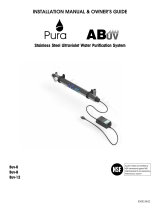
9
Installation
Step 1: Once both the orientation and location have been
selected, securely fasten the rack to a suitable
back-ing. As the rack system is extremely heavy
whenlledwithwater,itisimperativethatthe
rack be mounted with suitable fasteners for the
particular installation. Mounting to a drywall
backing is not suitable, unless the rack is
fastened directly to the wall studs.
Step 2: The use of a by-pass assembly is recommended
as it will allow you to isolate the UV system This
will allow for easier access in case maintenance is
required.
Step 3: Forwatersupplieswherethemaximumowrateisunknown,aow
restrictorisrecommendedsothattheratedowofyourparticularMicrolene
systemisnotexceeded.Theowrestrictorshouldbeinstalledontheinlet
port of the reactor.
Step 4: It is recommended to have a licensed plumber connect the UV reactor to the
water supply and may be a requirement depending on where you are located.
Step 5: Connect both the inlet and outlet to the rack system with the applicable
connections based on your particular plumbing requirements. The inlet port of
theltersisa1”FNPTconnec-tionandtheoutletportoftheUVreactorisa1”
MNPT connection.
Step 6: Once the system has been plumbed in, gently remove
the quartz sleeve from its packaging being careful not to
touch the length with your hands. The use of cotton gloves
is recommended for this pro-cedure as oils from the hands
can leave residue on the sleeve and lamp which can
ultimately block the UV light from getting to the water.
Carefully slide the sleeve into the reactor until you can feel
it hit the opposite end of the reactor. Align the sleeve so it
centered along the length of the reactor, then gently push
it in to lock it into the internal centering springs in the far side of the reactor.
CAUTION: Pushing too hard when the sleeve is not aligned can damage the
centering springs. Slide the o-ring onto the sleeve until it is butted up against
the reactor (See Figure 4).
Step 7: Hand tighten the provided gland nut over the quartz sleeve onto the threaded
endofthereactor.Ithasapositivestoptopreventover-tightening.Armforce
may be required to fully tighten the gland nut, but DO NOT USE TOOLS for
this step. Insert the provided stainless steel compression spring into the quartz
sleeve. The spring works with the lamp and lamp connector to create the
proper lamp alignment. PLEASE NOTE: DO NOT install a UV lamp inside the
quartz sleeve without the sleeve spring in place.
Step 8: Installtheltercartridgesintheirappropriatehousings.FortheMicrolenebrand-
edproducts,pleaserefertotheMicroleneRack-MountUVSystemSpecication
chart. PLEASE NOTE: This chart indicates the correct cartridge position for the
default“left-hand”orientationwiththewaterinletlocatedontheleftsideofthe
rack system. If the orientation was switched, the cartridge placement must also
beswitched.Oncethecartridgesareinplace,usethesup-pliedlterwrenchto
“snug”thelterhousingontothelterhead(SeeFigure5).
Figure 3. Lamp Removal Spacing
Figure 4. Quartz
Sleeve Installation





















